Wire clamps: existing types of clamps + detailed connection instructions
Electrical work related to electrical networks is inevitably accompanied by installation, maintenance, and repair.In turn, the listed service forces you to use clamps for wires of different configurations.
These are, as a rule, relatively small parts designed to work with different types and sizes of conductors. The base of existing clamps is large and it is quite difficult to cover the entire range of such accessories. However, there is a so-called “popular” set that is used most often.
Let's look at the most popular types of clamps, outline the scope and specifics of their application, and also provide detailed instructions for connecting wires using such technical accessories.
The content of the article:
Popular types of electrical clamps
In practice, the installation of electrical circuits uses special technical accessories - clamps of various designs. The specific application is determined by many criteria, ranging from the purpose of the network to the technical and operational parameters of the connections.
Type #1 - simple terminals with screws
What is remarkable about this type of accessory is that the terminal allows you to make a reliable connection without clearly disturbing the structure of the conductors. In this case, it is permissible to connect conductors based on different metals, for example, copper and aluminum.
Single-way terminals on a polypropylene (polyethylene) base are considered widespread in everyday practice.
The design is a metal, usually brass or bronze, short channel of small diameter, equipped with two threaded holes for fixing screws.
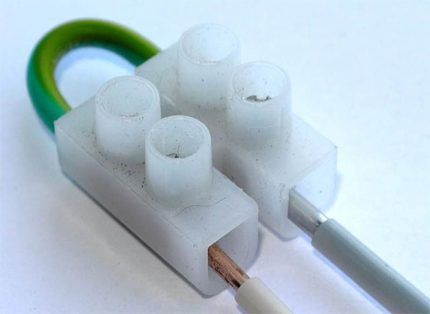
Such a metal channel is embedded inside a polyethylene shell, which has good insulating properties. In order to connect two separate conductors, the end parts of these conductors are placed in the channel on both sides, after which they are securely fixed (pressed) with screws.
There are different channel configurations terminals, based on installation parameters such as:
- conductor diameter,
- current characteristics,
- insulation class,
- number of contact points.
In fact, the selection of such accessories is possible for any technical conditions, especially those that are relevant for the household sector.
Type #2 - self-tightening and lever clamps
This type of connecting accessories is characterized by increased user convenience. For example, if you use disposable self-tightening clamps, simply insert the stripped end part of the wire all the way inside the clamp hole.
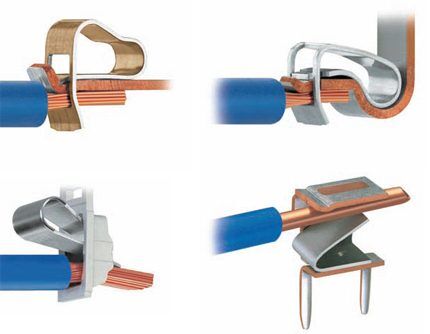
Inside the structure there is a spring plate, which is installed with the cutting part in the “opposite direction” of the conductor. When the wire is inserted into the channel all the way, the plate is pressed with a metal core and the “countermoving” part cuts into the body of the wire.
To release the conductor, you need to press the plate with a screwdriver through the hole in the second row. These types of clips are not reusable. They are enough for 3-4 times of repeated connections.

Numerous repeatability of connections is supported by similar designs, but supplemented with a press lever. The practical application of such accessories is simple.
It is enough to lift the lever perpendicular to the channel, insert the stripped conductor and lower the lever until it clicks. The wire will be securely fastened. Accordingly, the reverse operation is performed if the wire is released from the channel.
Type #3 - connecting insulating clamps
Accessories of this kind provide the connection of conductors of relatively small diameter. In fact, connecting insulating clamps (technical abbreviation - PPE) represent a kind of hand tool of the same twist.
Two or more pre-stripped ends of the conductors are formed into a group and “covered” with a connecting insulating cap until it stops. Then the cap is turned several times.
Inside such a system there is a spring spiral having a conical shape. As the cap is screwed on, the spiral wraps around a group of ends of the conductors and pulls them tightly into a single knot, pinching them inside.
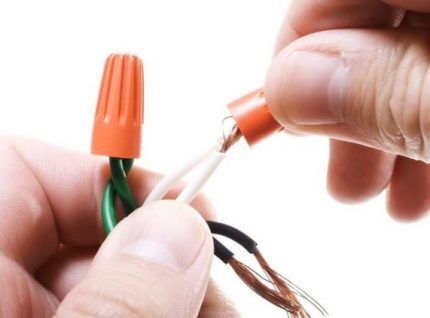
Cap connectors are used, as a rule, on electrical wiring of relatively low power.Very often this type of clamp is chosen during installation household in-house electrical networks.
There are two types of caps:
- cone-shaped straight shape without thrust protrusions;
- cone-shaped straight shape with persistent protrusions.
The second configuration, as a rule, has a slightly larger diameter and is intended for fastening conductors of larger diameter.
Type #4 - piercing clamping element
On electric lines with power up to 1 kV, piercing type clamps are often used. This type of accessory allows working with conductors with a cross section of 1.5 – 10 mm2 on branch lines or work with conductors 16 – 95 mm2 on main trunk lines.
The design is a metal plate girth covered with insulation, which is compressed by pressure from a thrust bolt.
The plates that wrap around the conductor are equipped with sharp metal teeth, which, under pressure, pierce the insulation of the wire and dig directly into the body of the conductor.
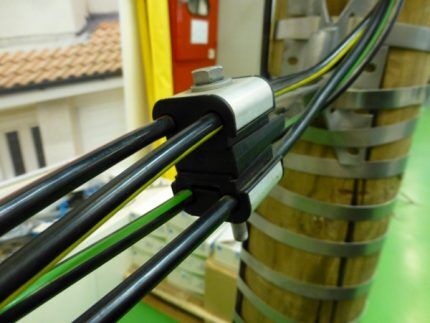
The advantages of such structures are obvious. Working with them allows you to avoid labor-intensive operations of removing insulation. In addition, the design of the piercing clamps is made in such a way that it allows you to perform work without turning off the power supply to the line.
Piercing type clamps provide a high degree of sealing against atmospheric influences.
Polymer insulation, resistant to ultraviolet radiation, is reinforced with fiberglass to enhance strength. There is an insulating rubber cap for the tip.
View #5 - clamp between bolt and nut
Often, on power networks, installers use a simple but quite reliable method of fastening through a regular bolt clamp.
To organize a connection of this kind, you need always available parts:
- bolt of suitable diameter;
- nut to bolt;
- two washers according to size;
- lock-nut.
In a similar way, it is permissible to connect dissimilar electrical conductors, for example, copper and aluminum.
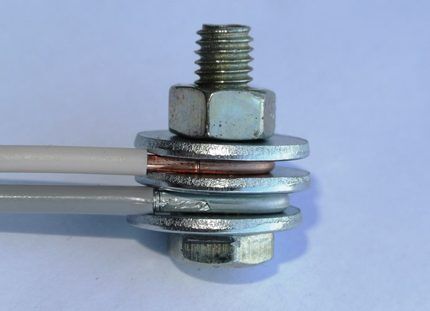
However, theoretically, such a combination is not recommended in electrical practice due to the different chemical properties of the metals.
Clamps for other purposes
In addition to the designs of clamps intended for connections electrical conductors, there is a variety of this kind of accessories for other purposes.
Anchor clamps for fastening
Designs of clamps for fastening (suspension) of wires with a cross-section of 2 – 25 mm2 in the amount of two to four cores. Structurally, the anchor accessory consists of a polymer body equipped with a self-adjusting clamping wedge.
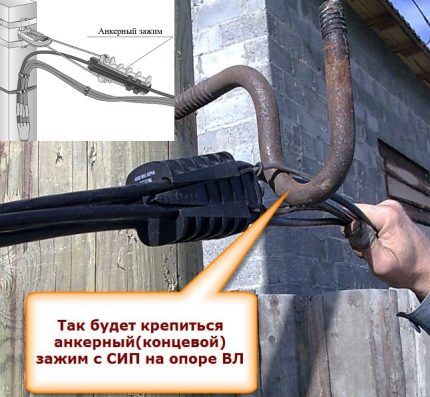
Two configurations of anchor clamps are available:
- for self-supporting systems;
- under an isolated carrier neutral.
The mechanism has an easy-to-open bow, making it convenient and easy to install the clamp on brackets, hooks, and then attach electrical wires to the body of the clamp.
Wire clamps for test needs
Often the practice of electronics and electrical engineering involves the use of clamps for so-called “test” purposes. Traditionally, such accessories are “crocodiles” - jagged sliding (push) metal structures.
The toothed part of such a clamp remains open, while the pressure part is insulated with PVC material.
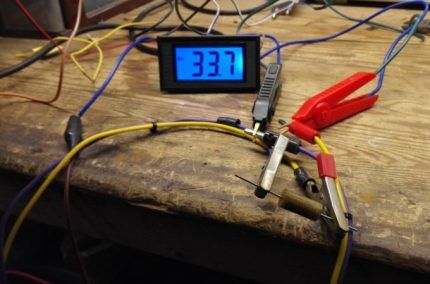
Such accessories are used for temporary attachment (engagement) to wires, for example, for the purpose of measuring current or network voltage.
This type of clamp can be divided into two categories - for low-voltage electronics and for high-voltage electrical networks. Both categories differ from each other in the limiting technical parameters for current.
Instructions for connecting wires with a clamp
Actually, the procedure for performing the work, in this case, is connecting wires using various types of clamps, simple and clear. It is quite possible to do it on your own.
The first step is to bring the working conductors to the interface. AND remove insulation at the area where the clamp is inserted into the sleeve.
Next, carefully clean the exposed end part to a characteristic shine - it’s better for work select stripper.
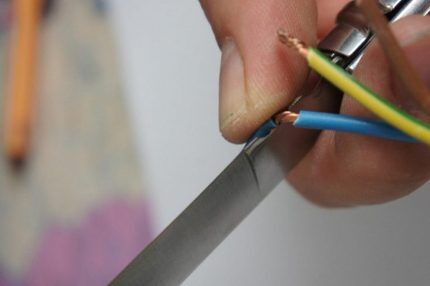
Now you need to insert the prepared ends inside the clamp sleeve and secure.
If necessary, such a connection can be additionally insulated.
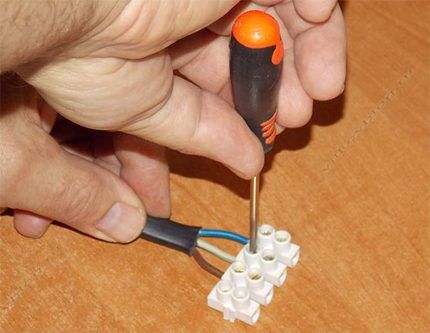
The work of connecting conductors is even easier when using a piercing type clamp or a self-aligning spring type clamp clamp type VAGO.
Conclusions and useful video on the topic
How to connect wires and what accessories to use in this or that version of the paper clip? The video talks about this in detail and shows:
A variety of mechanical elements that act as a reliable clamp greatly facilitates installation and adjustment work. Thanks to the use of such elements, the level of safe operation of electrical networks increases.
The only caveat is the correct use of such accessories, since a discrepancy in technical capabilities threatens to negate all the advantages of the clamps.
Do you have experience selecting and using wire clamps? Or want to ask questions on the topic? Please comment on the post and participate in discussions. The feedback block is located below.




I recently discovered a new type of wire clamp - Scotchlock. Convenient - you don’t even need to strip the wires, it’s quick - you insert it into the clamp and crimp it with pliers, it’s cheap - it costs mere pennies. True, the connectors are disposable.Another plus is the presence of moisture protection; there is a special hydrophobic gel inside the connector. The only negative is the scope of application: adhesive tapes are only suitable for low-current and low-voltage circuits, for example, telephony, computer networks, many connections in a car, etc.
Good afternoon, Gleb.
I’ll add my own invention to your collection of clamps - once, after a short circuit in a distribution box, I had to modernize it.
In the old box, the “phase” and “neutral” wires went under “one bolt”. I decided to use the following “Zero tires with DIN insulator “Rack” - screenshot below.
Very convenient reusable design, powerful clamping screws, strong threads. Each wire is securely fixed - phase/zero input, phase/zero output, outgoing wires. The result is in the second screenshot.
By the way, the convenience was tested a year later - an outdoor lighting fixture was powered through one of the distribution boxes without any hassle.
All these devices are quite convenient, but they will take a significant amount of time for people to get used to them and begin to actively use them. All the same, the twist, at best wrapped with electrical tape on top, will enjoy success with the average person for a long time and terrify more advanced and understanding people. Moreover, clamps made from the material above are not without their disadvantages.